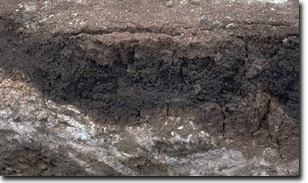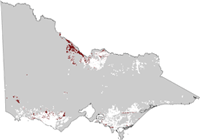Victorian Dairy Soils - Vertosols
Back to: Victorian Dairy Soil
| Vertosols are clay soils that shrink and swell, and crack as the soil dries. Gilgai ('crabholey') microrelief is commonly associated with these soils. Vertosols often have self-mulching surfaces, although more coarsely structured surface soils also occur. Subsoils are often sodic and can be calcareous at depth, usually with visible free calcium carbonate (lime). |  Black Vertosol in South West Victoria |
Distribution
| Vertosols occur mainly in floodplains, volcanic plains and old lake beds. In northern Victoria, Grey Vertosols predominate on large floodplains associated with the Murray and Loddon Rivers, whilst other streams have smaller occurrences. Grey Vertosols are most common, but can also be Red and Brown. Soil pit site GN8 is an example of a Grey Vertosol near Dookie. In south-west Victoria, Vertosols are most extensive on basalt plains and rises as well as on some alluvial plains, swamps and lunettes. Black and Grey Vertosols can occur throughout the basalt plains and often have self-mulching surfaces, although more coarsely structured surface soils also occur. Subsoils are often sodic and can be calcareous at depth. Soil pit site SW108 is an example of a Black Vertosol near Mt Gellibrand. In Gippsland, Vertosols are usually associated with floodplains in the Tarwin and La Trobe valleys. They can also occur in inter-dune swales in the Wonthaggi region. Soil pit site GP40 is an example of a Black Vertosol west of Yarram. |  |
Management Considerations
The surface of Vertosols can often be sodic and disperse significantly after remoulding. This indicates that tillage or overstocking of the soil whilst in a moist to wet condition may result in structural degradation (e.g. surface sealing, increased cloudiness, pugging) occurring. Gypsum application may assist in improving surface soil structural condition on such soils. The subsoil can often be sodic and coarsely structured, which will restrict root and water movement. Waterlogging is likely in wet seasons.
These high clay soils have a high wilting point value, indicating that plants will not be able to fully utilise light rains falling on relatively dry soil, as there will be insufficient moisture to wet the soil above the wilting point. This may result in moisture stress to plants in a dry spring. When the soil is dry, heavy rains will move down soil cracks. This rapid recharge can be valuable for the survival of plants near wilting. When wet, the soil will swell and further infiltration of water will be relatively slow.
Physical disturbance of cracking clay soils should be avoided if the soil is wet (i.e. wetter than the plastic limit). At such moisture conditions, tillage or excessive trafficking or overstocking could result in structural damage (e.g. compaction, smearing) occurring. Ideally, tillage and trafficking should take place on cracking clay soils when the soil is drier than the plastic limit, down to at least the tillage depth.
The subsoil can often be strongly alkaline, particularly in northern Victoria and on soils developed on basalt in south-west Victoria. This indicates that phosphorus and some trace elements such as iron, manganese, zinc and copper may be poorly available to plants and deficiencies may occur. Deficiencies can be determined by plant tissue analysis. Boron toxicity can also occur in strongly alkaline soils.


